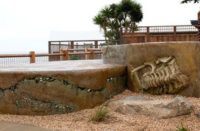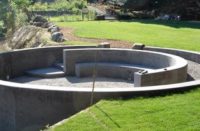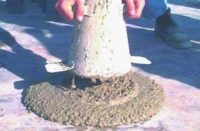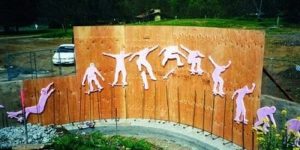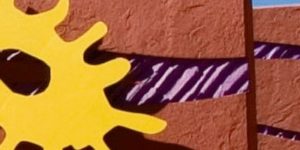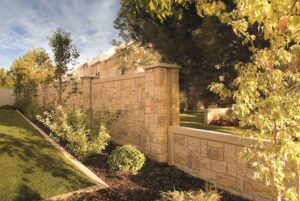
Concrete has always had advantages over brick- and stone-constructed walls — cost, strength and durability to name a few — and now concrete competes in appearance as well.
The growing availability of a huge variety of decorative form liners now allows contractors to make concrete walls match just about any kind of brick or stone wall out there. Add color to these realistic, textured surfaces and the result can fool even the most savvy home and garden buff.
Many customers, be they homeowners, developers or government highway officials, are looking for alternatives to utilitarian concrete. They want their concrete walls to have the look of more expensive masonry materials and they’re willing to pay for the craftsmanship to get it.
Decorative concrete walls are showing up on subdivision entrances, retaining walls, landscape structures and patios. On highway projects, contractors are building sound barriers or bridge abutments to look like stone walls from the region. Some serve as canvases for local artists, who have discovered that concrete can display fine detail.
Bob Ware, president of The Decorative Concrete Store in Cincinnati, Ohio, uses Increte Systems Inc.’s Stone-Crete, a patented poured-in-place concrete wall system that produces deep-relief stone walls in seven patterns.
For example, he says, Sedona, a rough-cut, weathered Arizona stone pattern, is popular in the Southwest. Round river rock patterns are more common in Michigan and Wisconsin. Dry stack stone, with its many thin layers of rock, is popular in the Midwest. Cocina, a pattern with the appearance of sand and bits of shell, is popular in southern climates.
Ware says the form liners are made with a keystone system that disguises seams and prevents a repetitious look.
 Custom Rock International’s Jim Bohrer, director of wall systems, says the St. Paul, Minn., manufacturer makes 30-plus patterns that replicate rock, cut stone, brick, barn wood and more. As its name implies, the company can also make custom molds for any project by forming a urethane membrane or skin over an existing wall, or by making molds from stones sent to its plant.
Custom Rock International’s Jim Bohrer, director of wall systems, says the St. Paul, Minn., manufacturer makes 30-plus patterns that replicate rock, cut stone, brick, barn wood and more. As its name implies, the company can also make custom molds for any project by forming a urethane membrane or skin over an existing wall, or by making molds from stones sent to its plant.
Custom Rock can take a mold from a local landmark, such as a church or town hall, and reconstruct the look on a new bridge or wall in the community.
Custom Rock’s forms, typically 4 feet to 10 feet long, are rotatable, reversible, and/or keyed to provide multiple looks that mimic nature. “Our surface textures are second to none because we’re taking it off the real stone. We’re not making it up,” Bohrer says.
A good long-term investment
Many contractors swear by flexible, reusable form liners for pour-in-place projects, because they are easy to handle and less expensive than standard forms. They come with varying life spans: some are disposable; some endure 10 or more pours; some 40 or more.
Contractors can rent form liners because buying them can be expensive — one 12-square-foot section may cost $1,200 — but for wall contractors it’s a good investment over time, Ware says, because the flexible rubber can be peeled off the wall and used again and again. “If it’s just a one-time job, the throwaways might be the way to go. But if you’re getting into the business, you might look into reusable forms.” The result can be high profits for contractors, he says.
 More cost-effective, more durable than veneers
More cost-effective, more durable than veneers
One way to create a more decorative exterior surface is to pour the concrete wall, then overlay it with a veneer of real stone or brick. But that gets expensive. Doug Bannister, owner of The Stamp Store in Oklahoma City, says the same effect can be achieved less expensively by pouring a concrete wall using a form liner. A concrete wall can be thinner, yet structurally sound, and since it’s one piece, there’s no risk of individual stones or bricks knocking loose from the mortar. “Concrete is more affordable and offers more design options than other materials,” Bannister says.
He added that self-compacting concrete is the perfect finish for textured walls because it’s tight and self-consolidating, so it fills in all the nooks and crannies of decorative form liners without leaving any gaps or holes.
Coloring adds realism
But just pouring concrete into a realistic form liner isn’t enough to give a wall the realistic look of rock, because real rock isn’t one uniform, gray color.
Ware says a subtle integral color can be added to the concrete batch, and then, after the forms are removed and the wall is cleaned, two or three workers can use a colored release agent or an acid stain to randomly rub color into individual stones. Some contractors leave the natural gray concrete on roughly 40 percent of the stones, and shade the other 60 percent with light beige and reddish tones. Ware says even the “good old concrete look” works in certain conditions. After two or three years of aging, it will take on its own natural staining.
Harlan Baldridge, manager of the decorative concrete division of Cut ’N Break Construction in Medford, Ore., prefers to spray on color hardeners, but notes there are many different methods for achieving a realistic look. “There seems to be a lot of people out there who are coming up with their own ways of making vertical concrete look as good as flatwork.”
When walls are colored, a sealer is generally required. One or two coats should be applied, and then no maintenance is required for up to 10 years. If it does need to be cleaned, simple soap and water will do. Custom Rock’s Bohrer says the stains on their decorative walls have held up 14 years and will probably go another 10.
 Highway projects as art
Highway projects as art
Buck Scott, president of Scott System Inc., of Aurora, Colo., says more creativity is almost a must in the market place these days, even when it comes to highway noise barriers. “It’s more than just pour some concrete and throw it out in the neighborhood,” he says. Homeowners simply won’t stand for an imposing concrete neighborhood wall backing up to a busy street or highway. They want something that replicates stones from their area or adds an artistic element to their community.
Scott’s company has extensive experience working with artists, highway officials and homeowners to create sound barriers and retaining walls that are eye-popping public art projects. Scott was one of the first to create textures in concrete. He invented the elastomeric-urethane form liner 30 years ago, and has created more complicated patterns and designs ever since.
The company recently worked with Denver artist Carolyn Braaksma to create molds for huge graphic elements along an eight-mile stretch of the Pima Freeway in Scottsdale, Ariz. A 67-foot lizard, cacti, and a range of textures in mauve, sage and purple transform a utilitarian retaining wall into a work of art. The company is again working with Braaksma to produce liners for a 25-foot-tall buffalo, soaring swallows and an abstract map of Denver on huge retaining walls along Interstates 225 and 25, which run through the city.
Highway arts projects like these have not been vandalized, Scott says, while a smooth concrete surface would be a magnet for graffiti.
 Pre-cast wall systems
Pre-cast wall systems
Another alternative to a plain concrete retaining wall is a brick-in-concrete wall. Scott System offers a precast wall system with 5⁄8-inch brick integrally cast into concrete panels. Homeowners who abut sound barriers are opting for brick walls over plain concrete in their back yards, because it combines the sound-absorbing qualities of concrete with the beauty of brick. Scott System recently used this method to build brick-in-concrete fence posts across from Denver’s Coors Field. Brick-in-concrete has been used on many sound and retaining barriers, including I-25 in Colorado Springs and a pedestrian bridge over Highway 610 in Detroit.
Help for existing walls
There are ways to improve existing walls, too. Ware says Texture-Crete is a decorative overlay system that looks like stone or brick, cobblestone or other patterns. A stencil is placed on a wall and a colored spray texture is shot onto it. When the stencil is removed, a gray concrete mortar joint and a textured surface are left behind.
He also recommended adding a decorative cap to put a new twist on an old wall.
Cameron Morgan, general manager of Pacific Concrete Images of Laguna Hills, Calif., offers a forming system for making poured-in-place decorative wall caps in six standard architectural profiles. One of their best-selling products is Pacific Formliner, reusable polyethylene form liner that is more flexible, durable and easier to handle than the foam alternative. The form liners can bend to almost any radius without breaking, he says, and it’s reusable so it’s popular with contractors. “Once they use our stuff, they get rid of all their others.”
 Morgan says residential use of these wall caps is booming, as a $2 million home in Orange County is “no big deal.” Neighborhood associations require homeowners to make landscaping improvements to new homes, and the homeowners are responding by putting in decorative walls with caps. “It creates a little more grandiose appearance.”
Morgan says residential use of these wall caps is booming, as a $2 million home in Orange County is “no big deal.” Neighborhood associations require homeowners to make landscaping improvements to new homes, and the homeowners are responding by putting in decorative walls with caps. “It creates a little more grandiose appearance.”
Bannister, who worked as a contractor for 30 years before becoming a supplier, has used Stegmeier Corp.’s forms for wall caps. Stegmeier makes wall cap forms that are reusable foam forms in five styles to pour concrete caps atop block walls, glass block walls, planters and more.
Bannister says contractors are adding more décor to vertical surfaces by adding color and texture, and the methods for doing so are many.
Contractors are using decorative form liners, which are removed after initial curing. Another application is troweling on or spraying grout on an existing wall and imprinting with rubber tools, much like stamping to replicate dry stacked sandstone or fieldstone. This material is carvable the next day.
More people are understanding the versatility of concrete, which can take any shape and any color, Bannister says. “There are now affordable techniques and accomplished craftsmen who can make concrete beautiful.”
